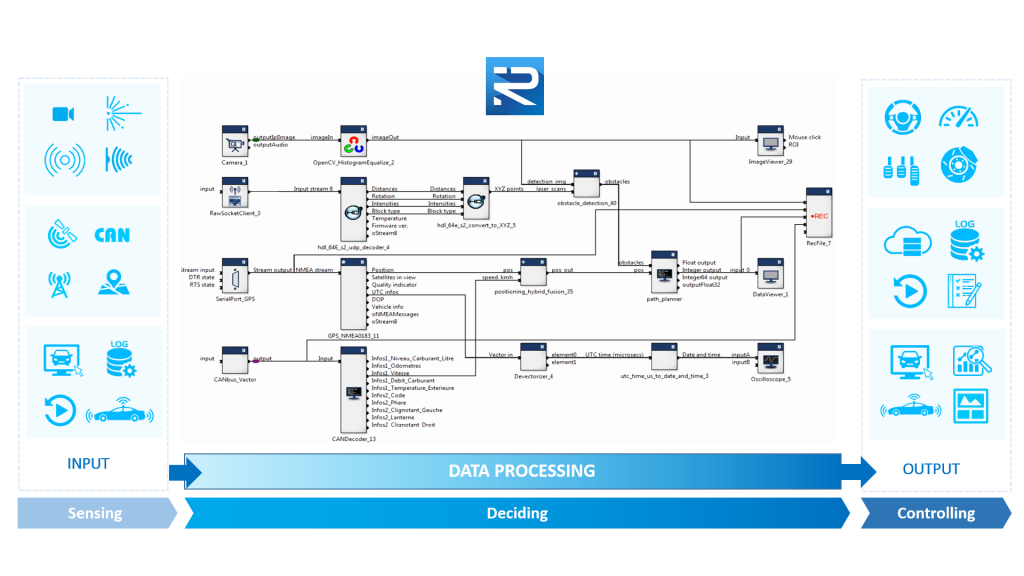Data Collection
The main point of a driving simulation experiment is to collect data relevant to our study. This includes both simulation related data (e.g. speed), but also physiological data, such as eye-tracking or heart rate; all of which need to be synchronized. Today we’ll discuss how we solve this in our platform.
A bit of (our) history
Up until a few years ago, the amount of data sources in our experiments was pretty limited; we’d rarely go beyond simulation plus one physiological source. Even just two data sources raise the issue of synchronization between them, but this would be answered by one-to-one connection between the sources, or manual post-acquisition resynchronization.
Recently, we’ve been using more and more data sources for multiple reasons: broadening of our research areas, new emerging physiological data acquisition tools, or the rise of cheap IoT devices. We’ve done driving simulation connected with tablets, Launchpads, eye-tracking, EEG, ECG, respiration measurement, EDA, fNIRS and even within an MRI!
Obviously, we didn’t use all of them at once, but still, even just a few of those within an experiment requires a more robust way to synchronize them; our previous workflow doesn’t scale up.
RTMaps
RTMaps™ stands for Real-Time Multisensor Applications, it is a highly-optimized component-based development and execution software tool. Thanks to RTMaps™ you can design, develop, test, benchmark and validate multisensor applications for Advanced Driver Assistance Systems (ADAS) and Highly Automated Driving (HAD) software functions but also advanced features in other domains such as autonomous and mobile robotics, energy, system monitoring, complex instrumentation and human factors.
Mostly designed for ADAS development, this tool can read and synchronize many data sources, which then can be manipulated to provide outputs, or simply recorded. It natively supports most car-related data sources, and over time keeps adding support for other sources closely related to driving studies. And you can quite easily add your own custom data sources, so no worries there.
Even though the tool is great, it’s not perfect for driving simulation experiment data collection. First, it’s quite expensive; it’s actually by far the most expensive tool in our whole experiment toolchain. Its recording format also isn’t easy to work with, since it can’t natively be opened by any data wrangling tool out there (e.g. pandas). And since the tool is mostly for real-time data processing and we’re mostly doing recording, there’s a whole aspect of the tool that we don’t use, making it needlessly complex for our use cases.
LabStreamingLayer
The lab streaming layer (LSL) is a system for the unified collection of time series measurement in research experiments that handles the networking, time-synchronization, (near-) real-time access as well as optionally the centralized collection, viewing and disk recording of the data.
LabStreamingLayer is an open-source project designed exactly for our needs. It supports a wide range of physiological collection hardware, offers a recording tool and a Python library to read recordings. It has bindings to most languages, meaning you can easily add new data sources and, if you want, open-source them so that others can also benefit.
When we started working with Unreal Engine, LSL didn’t have an official UE4 integration, but through collaborative work, there now is a UE4-LSL Plugin.
The plugin makes it very simple to send and receive data to and from the LSL network.
And in our platform, we didn’t stop at that: the LabRecorder has a TCP interface for remote control, which we integrated using a TCP Plugin. That way, we can trigger recording start/stop, configure output file path and more, directly from scenarios. For example, recording automatically starts when the scenario is loaded, and the scenario name (along with its variants’ values) is added to the recording file directory name. This means less work for the experimenter during the experiment and when analysing data, and less risk of errors throughout the whole process.
The LabStreamingLayer community is very welcoming, and it’s great to be able to get help and simply exchange with people facing similar challenges as ours. It’s also rewarding to contribute to this open-source project, making our developments available to researchers around the world.

